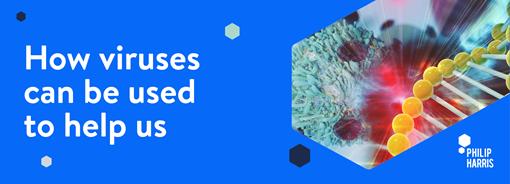How viruses can be used to help us

Viruses can be used to help us in a number of ways. There are some ground breaking research projects into how viruses can be used in the treatment of cancer using gene therapy, to their use in treatment of genetic disease. Viruses are used for measles, mumps, rubella, flu, rabies and HPV vaccines for a number of years. When we think of the word virus, most people think of something that makes us ill. But increasingly in scientific research, viruses are being used to help us!
What is a virus?
The simple definition of a virus is: An infectious agent of a small size and simple composition that can multiply only in living cells of animals, plants or bacteria. They have unique infective properties and often cause disease in host organisms.
Source: Britannica
It is because they are simple systems that viruses can be used to help us.
How are viruses used to help us?
There are a number of research projects taking place into how viruses can be used to help us, our top three are:
- Treatment of cancer
- Treatment of genetic disease
- Used for vaccines or vaccine delivery agents
Viruses used in gene therapy for cancer treatment
Gene therapy is currently in the early stages of research as a cancer treatment. As suggested in its title, gene therapy uses genes to treat illness. As our understanding of how cancer cells differ from normal cells increases, gene therapy can be used in cancer treatment,
The most difficult part of gene therapy is getting the genes into the cancer cells,. This is where the virus helps us...
To get to the cancer cells. genes need a carrier, also known as a vector. Viruses are an ideal vector as they can enter cells and deliver the gene.
Before being used as a carrier, the virus is ‘changed’ in the lab, so it can no longer cause serious disease.
Scientist are also working on ways to ‘change’ viruses so they can target cancer cells and kill them, whilst leaving healthy cells alone. As this sort of treatment is using the virus to kill the affected cells rather than deliver the gene, it is not a true cancer gene therapy. But is still using viruses to help combat the disease.
Source: Cancer Research UK
Using viruses in the treatment of genetic disease
A genetic disease is a disease caused by a change or a mutation in a persons DNA, or genetic make-up. Gene therapy is used to introduce genetic material into cells to compensate for these changes or mutations. In the case of a mutation, gene therapy may be able to introduce a ‘normal’ copy of the gene.
As in the treatment of cancer, the difficulty is in introducing the gene to the cells. So the viruses are used as the vector to carry the gene. As with cancer gene therapy, the virus is 'changed’ so it can no longer cause disease.
The vector can be given to the patient in different ways. It can injected into a specific tissue and taken up by individual cells. Alternatively, sample cells can be taken from the patient and exposed to the vector in a lab, and then reintroduced to the patient.
Again, this treatment is still in the early stages of research, as scientists work hard to overcome some of the challenges they still face in order for this to become a practical approach to treating these diseases.
Viruses as vaccines and vaccine delivery agents
Viruses can also be used to produce vaccines against the disease they cause. By introducing small amounts of a virus into a patient, in the virus can trigger ‘memory cells’ that will protect against future infections. There are several different methods of using viruses in vaccines:
Live vaccines: attenuated (weakened) versions of the virus
The virus can be weakened, which means it will lose its ability to reproduce rapidly in the body, and so will only reproduce a limited number of times. This will stop the virus causing a disease, but allow it to replicate well enough to induce the ‘memory cells’ that allow protection against infection in the future.
Vaccines for measles, mumps and rubella (MMR) are produced in this way. These vaccines can cause slight symptoms of the disease and are therefore not suitable for people with weakened immune systems.
Whole killed vaccines
The virus can also be completely killed in the lab, which means it won’t be able to replicate at all, or produce disease or infection. But the inactivated virus can still be seen by cells of the immune system, and cells to protect and fight the virus can be generated.
This type of vaccine cannot cause any form of the disease that it prevents and is suitable for people with weakened immune systems. The drawback of this method is that it usually requires several doses of the inactive virus to gain immunity from disease.
Vaccines for rabies and influenza are produced in this way.
Viruses in recombinant vaccines
Vaccines can also be prepared from using only part of the virus. The vaccine uses a protein that can be found on the surface of the virus. This type of vaccine can also be given to people with weakened immune systems and gives long lived immunity after 2 doses.
This method is used in the HPV vaccine, which is now given to girls and boys age 12-13 throughout England. It protects against certain cancers and diseases caused by the high risk types of the HPV virus.
These are of course just three of many ways in which viruses can be used to help us. Have you learned of any more ways viruses can help us? Tell us all about it on our Twitter and Facebook pages.






